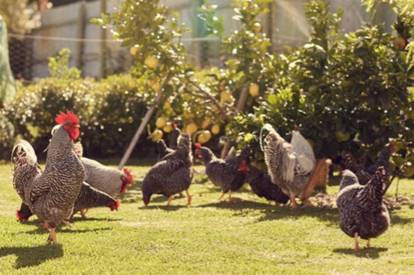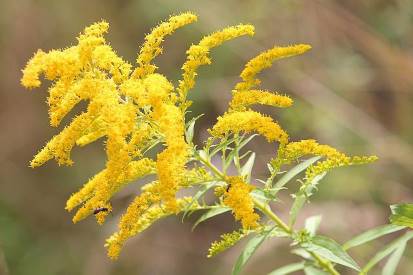Can chickens eat goldenrod? When it comes to feeding backyard chickens, there are a lot of myths and misconceptions out there. One of the most common is that chickens can’t eat certain plants or flowers. In reality, most anything that a chicken would find in the wild is fair game – with a few exceptions.
There is a lot of conflicting information out there about feeding goldenrod to livestock. Today we’ll be discussing the benefits of giving your chickens goldenrod, and what to watch out for when feeding this plant.

What is Goldenrod?
Goldenrod (Solidago genus) is a member of the Asteraceae family, which also includes daisies, asters, and sunflowers. Goldenrods are native to North America, and they can be found growing in fields, meadows, and along roadsides.
These perennial plants are characterized by their tall, slender stems and their small, bright yellow flowers. Goldenrods typically bloom from late summer to early fall, and they are an important source of nectar for bees and other pollinators.
Many people believe that goldenrods cause hay fever, but this is actually not the case. The pollen of goldenrods is too heavy to be airborne, so it is not the culprit for seasonal allergies.
Instead, the pollen of Ragweed (Ambrosia artemisiifolia), which blooms at the same time as goldenrod, is the true allergy trigger.
Despite this misconception, goldenrods are still widely appreciated for their beauty and their importance to the ecosystem.
[ChickenAffiliate]
Can Chickens Eat Goldenrod?

Yes, chickens can eat goldenrod. In fact, this plant is a great source of nutrients for your flock. Goldenrods are high in protein, vitamins, and minerals, and they can be a valuable addition to your chicken’s diet.
The leaves, stems, and flowers of goldenrod are all edible, and they can be fed fresh or dried. If you choose to feed your chickens fresh goldenrod, you can simply pluck the leaves and stems from the plant and offer them to your flock.
Dried goldenrod can be added to your chickens’ food or given as a treat. This is a great way to add some variety to your chickens’ diet, and it’s also a good way to ensure that they’re getting all the nutrients they need.
Just like with any other food, it’s important to introduce goldenrod slowly to your chickens. Start by offering a small amount and increase the amount gradually over time. This will help your chickens get used to the new food and avoid digestive problems.
Why Do Some Consider Goldenrod Toxic to Chickens?
The confusion surrounding goldenrod and whether it is toxic or not lies with a similarly named plant – rayless goldenrod. Unlike goldenrod which is part of the Solidago genus, rayless goldenrod (Haplopappus heterophyllus) is part of the Isocoma pluriflora.
This plant is sometimes known as “false goldenrod” because it shares many similarities with its namesake. Both plants are native to North America, and they have similar appearances.
The main difference between these two plants is that rayless goldenrod contains a toxic compound called tremetol. This compound can cause liver damage in chickens, and it can even be fatal in large doses.
For this reason, it’s important to make sure that you’re feeding your chickens goldenrod (Solidago genus) and not rayless goldenrod (Isocoma pluriflora).
Additionally, goldenrod typically grows in open areas while rayless goldenrod is more likely to be found in wooded areas. This can make them difficult to tell apart, which is why it’s important to be able to identify both plants.
If you’re unsure which plant you have, it’s best to err on the side of caution and not feed it to your chickens.
How to Tell the Difference Between Goldenrod and Rayless Goldenrod

Goldenrod and rayless goldenrod can be difficult to tell apart, but there are a few key differences that you can look for.
First, goldenrod typically grows in open areas while rayless goldenrod is more likely to be found in wooded areas. Second, goldenrod has long, slender leaves that are arranged in a spiral around the stem.
Rayless goldenrod, on the other hand, has shorter, wider leaves that are arranged in opposite pairs along the stem. Finally, goldenrod flowers grow in dense clusters at the ends of the stems while rayless goldenrod flowers are more spread out.
If you’re still unsure which plant you have, you can consult a local expert or take a sample of the plant to your local Cooperative Extension office for identification.
What are the Benefits of Feeding Chickens Goldenrod?
Goldenrod is a great source of nutrients for your flock. As we mentioned earlier, goldenrods are high in protein, vitamins, and minerals.
They’re also a good source of fiber, which can help keep your chickens’ digestive system working properly. Additionally, goldenrod is known to have anti-inflammatory and antibacterial properties.
This means that it can help reduce the risk of infections and diseases in your flock.
Are There Any Risks to Feeding Chickens Goldenrod?

Despite all of the benefits of feeding chickens goldenrod, there are a few things to keep in mind.
First, as we mentioned earlier, it’s important to make sure that you’re feeding your chickens goldenrod (Solidago genus) and not rayless goldenrod (Isocoma pluriflora).
Second, it’s best to introduce goldenrod slowly to your flock. Start by offering a small amount and increase the amount gradually over time.
This will help your chickens get used to the new food and avoid digestive problems. Finally, as with any other food, it’s important to offer goldenrod in moderation.
Too much of any one food can lead to nutritional imbalances and health problems, so be sure to offer a variety of foods to your flock.
How Often Should Chickens Eat Goldenrod?
Chickens can eat goldenrod as often as they like, but it’s best to offer it in moderation. A good rule of thumb is to offer goldenrod a few times per week as part of a balanced diet.
What is the Best Way to Feed Chickens Goldenrod?
The best way to feed chickens goldenrod is to offer it fresh. You can do this by placing goldenrod in your chicken coop or run.
If you have a lot of chickens, you may need to provide more than one plant so that everyone can access it.
You can also offer goldenrod as part of a foraging mix. This can be a great way to keep your chickens entertained and encourage them to get outside and exercise.
If you decide to feed goldenrod to your chickens, be sure to observe them closely for any signs of digestive upset. If you notice any problems, discontinue feeding goldenrod and consult your veterinarian.
What Other Plants Can Chickens Eat Apart From Goldenrod?
Goldenrod is not the only plant that can supplement the diet of chickens. A myriad of other plants, including some flowers, offer nutritional benefits that are excellent for the health of your poultry. Exploring other plant options can provide a more balanced diet and offer variety to the flock. Below, we’ll examine five such plants and assess their suitability for chickens.
Dandelions
Dandelions are not just weeds; they are a power-packed source of nutrition for chickens. These plants are rich in vitamins A, B, C, and D, as well as minerals such as potassium, iron, and zinc. Chickens can eat every part of the dandelion: leaves, stems, flowers, and even the roots. Dandelions can act as a natural wormer, a factor that makes them a chicken-friendly plant.
Read More: Can Chickens Eat Dandelions? Unveiling A Golden Feast
Poison Ivy
While chickens are known to eat many types of plants, it is crucial to know that not all are safe for them. Poison ivy is one of these. Chickens can eat poison ivy without falling ill themselves, but they can pass the plant’s urushiol oil (the component that causes an allergic reaction in humans) through their eggs and droppings.
So while the plant isn’t directly harmful to chickens, it can indirectly cause issues for humans handling these chickens or their products.
Read More: Can Chickens Eat Poison Ivy? Unraveling The Poultry Paradox
Marigolds
Marigolds are another chicken-friendly plant option. Not only are they safe for chickens to eat, but they also have several health benefits. Marigolds contain xanthophylls, which can enhance the color of egg yolks when added to the diet. Additionally, they have anti-inflammatory and antibacterial properties, which can support the overall health of the flock.
Read More: Can Chickens Eat Marigolds? 6 Surprising Benefits
Hibiscus
Hibiscus is a great choice for chickens. They can safely consume both the flowers and leaves. These plants are rich in vitamin C, and the flowers are known to be a favorite among many chickens due to their vibrant colors and sweet taste. Moreover, hibiscus plants can also provide shade for the flock during the hot summer months.
Read More: Can Chickens Eat Hibiscus? Discover Health Benefits & More
Comfrey
Comfrey is a good plant for chickens to eat. It is packed with protein and is a rich source of vitamins A, C, and E, as well as minerals like calcium and potassium. It is known to support the respiratory health of chickens and can promote faster healing of any wounds. However, comfrey should be fed in moderation as it contains certain alkaloids that can be harmful in large amounts.
Read More: Can Chickens Eat Comfrey? 6 Excellent Benefits
Can Chickens Eat Goldenrod – Final Thoughts
Chickens can eat goldenrod, and it provides many benefits. However, it’s important to make sure that you’re feeding your chickens goldenrod (Solidago genus) and not rayless goldenrod (Isocoma pluriflora).
Additionally, it’s best to introduce goldenrod slowly to your flock and offer it in moderation. By following these simple guidelines, you can safely add goldenrod to your chickens’ diet.
Related Articles:
